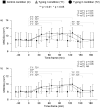Impact of keyboard typing on the morphological changes of the median nerve
- PMID: 28701627
- PMCID: PMC5635149
- DOI: 10.1539/joh.17-0058-OA
Impact of keyboard typing on the morphological changes of the median nerve
Abstract
Objectives: The primary objective was to investigate the effects of continuous typing on median nerve changes at the carpal tunnel region at two different keyboard slopes (0° and 20°). The secondary objective was to investigate the differences in wrist kinematics and the changes in wrist anthropometric measurements when typing at the two different keyboard slopes.
Methods: Fifteen healthy right-handed young men were recruited. A randomized sequence of the conditions (control, typing I, and typing II) was assigned to each participant. Wrist anthropometric measurements, wrist kinematics data collection and ultrasound examination to the median nerve was performed at designated time block.
Results: Typing activity and time block do not cause significant changes to the wrist anthropometric measurements. The wrist measurements remained similar across all the time blocks in the three conditions. Subsequently, the wrist extensions and ulnar deviations were significantly higher in both the typing I and typing II conditions than in the control condition for both wrists (p<0.05). Additionally, the median nerve cross-sectional area (MNCSA) significantly increased in both the typing I and typing II conditions after the typing task than before the typing task. The MNCSA significantly decreased in the recovery phase after the typing task.
Conclusions: This study demonstrated the immediate changes in the median nerve after continuous keyboard typing. Changes in the median nerve were greater during typing using a keyboard tilted at 20° than during typing using a keyboard tilted at 0°. The main findings suggest wrist posture near to neutral position caused lower changes of the median nerve.
Keywords: carpal tunnel syndrome; keyboard typing; median nerve; ultrasound.
Conflict of interest statement
Figures




References
-
- Dennerlein JT, Johnson PW. Different computer tasks affect the exposure of the upper extremity to biomechanical risk factors. Ergonomics 2006; 49: 45-61. - PubMed
-
- Huysmans MA, Ijmker S, Blatter BM, et al. . The relative contribution of work exposure, leisure time exposure, and individual characteristics in the onset of arm-wrist-hand and neck-shoulder symptoms among office workers. Int Arch Occup Environ Health 2012; 85: 651-666. - PubMed
-
- Dias JJ, Burke FD, Wildin CJ, Heras-Palou C, Bradley MJ. Carpal tunnel syndrome and work. J Hand Surg Eur Vol 2004; 29: 329-333. - PubMed
-
- Atroshi I, Gummesson C, Johnsson R, Sprinchorn A. Symptoms, disability, and quality of life in patients with carpal tunnel syndrome. J Hand Surg 1999; 24: 398-404. - PubMed
Publication types
MeSH terms
LinkOut - more resources
Full Text Sources
Other Literature Sources

